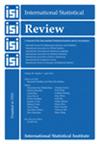估算最高密度区域的其他方法
IF 1.8
3区 数学
Q1 STATISTICS & PROBABILITY
引用次数: 0
摘要
摘要 在各种统计区间中,最高密度区域(HDR)因其能够有效概括分布或样本、揭示其独特而突出的特征而脱颖而出。HDR 代表满足特定概率覆盖范围的最小大小集合,而当前计算 HDR 的方法需要了解或估计基本概率分布或密度。在这项工作中,我们展示了一个计算 HDR 的更广泛框架,它对经典的密度量化方法进行了概括。该框架以邻域度量为基础,也就是保持样本中由 , 引起的秩的度量,并将密度作为特例。我们探讨了一些合适的基于距离的测量方法,如最近邻域距离,以及一些基于 copula 模型的概率变体。我们进行了广泛的比较,显示了基于 copula 的策略的优势,尤其是在结构复杂的情况下(如多模态或特殊依赖关系)。最后,我们讨论了我们的研究结果对实际应用中估计 HDR 的实际意义。本文章由计算机程序翻译,如有差异,请以英文原文为准。
Alternative Approaches for Estimating Highest‐Density Regions
SummaryAmong the variety of statistical intervals, highest‐density regions (HDRs) stand out for their ability to effectively summarise a distribution or sample, unveiling its distinctive and salient features. An HDR represents the minimum size set that satisfies a certain probability coverage, and current methods for their computation require knowledge or estimation of the underlying probability distribution or density . In this work, we illustrate a broader framework for computing HDRs, which generalises the classical density quantile method. The framework is based on neighbourhood measures, that is, measures that preserve the order induced in the sample by , and include the density as a special case. We explore a number of suitable distance‐based measures, such as the ‐nearest neighbourhood distance, and some probabilistic variants based on copula models . An extensive comparison is provided, showing the advantages of the copula‐based strategy, especially in those scenarios that exhibit complex structures (e.g. multimodalities or particular dependencies). Finally, we discuss the practical implications of our findings for estimating HDRs in real‐world applications.
求助全文
通过发布文献求助,成功后即可免费获取论文全文。
去求助
来源期刊

International Statistical Review
数学-统计学与概率论
CiteScore
4.30
自引率
5.00%
发文量
52
审稿时长
>12 weeks
期刊介绍:
International Statistical Review is the flagship journal of the International Statistical Institute (ISI) and of its family of Associations. It publishes papers of broad and general interest in statistics and probability. The term Review is to be interpreted broadly. The types of papers that are suitable for publication include (but are not limited to) the following: reviews/surveys of significant developments in theory, methodology, statistical computing and graphics, statistical education, and application areas; tutorials on important topics; expository papers on emerging areas of research or application; papers describing new developments and/or challenges in relevant areas; papers addressing foundational issues; papers on the history of statistics and probability; white papers on topics of importance to the profession or society; and historical assessment of seminal papers in the field and their impact.
 求助内容:
求助内容: 应助结果提醒方式:
应助结果提醒方式:


